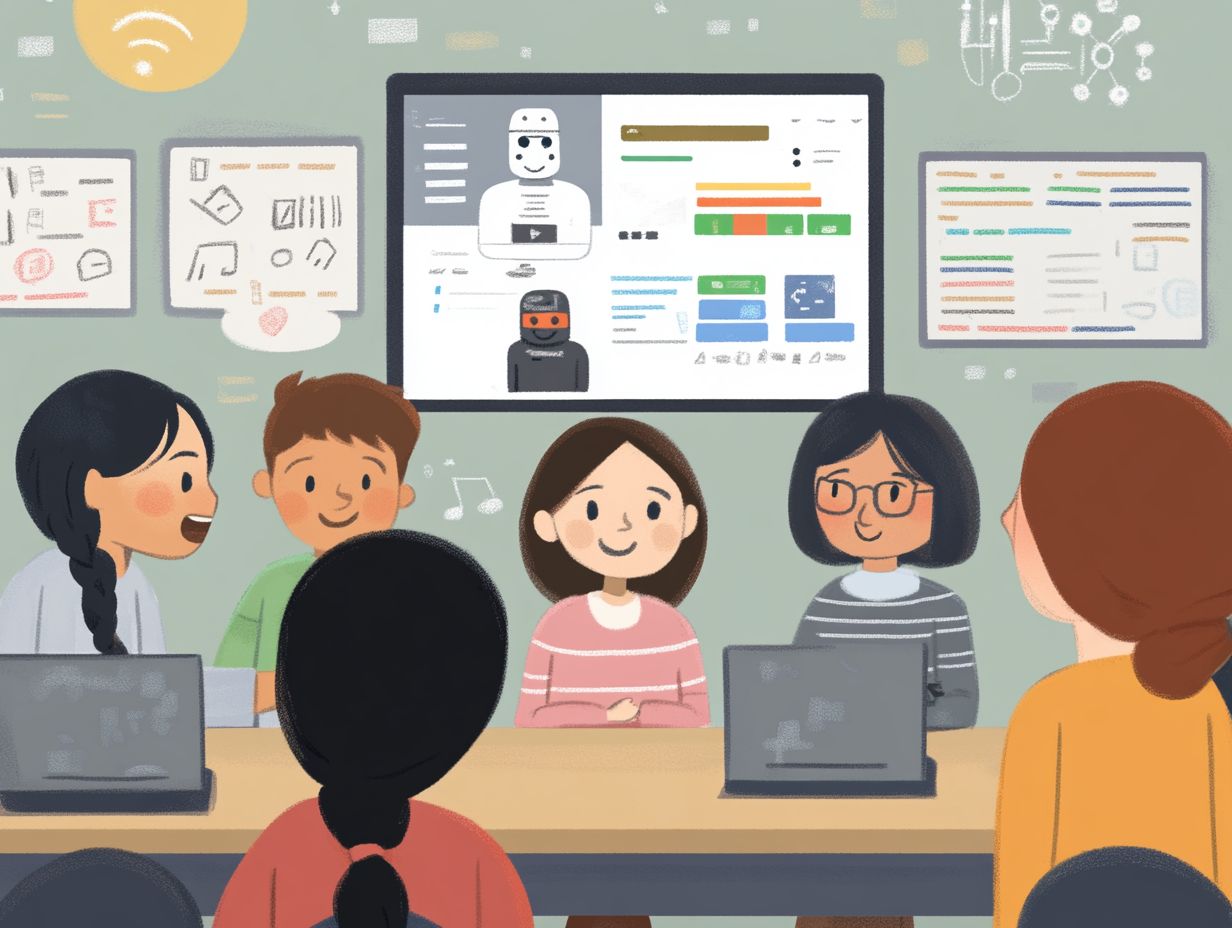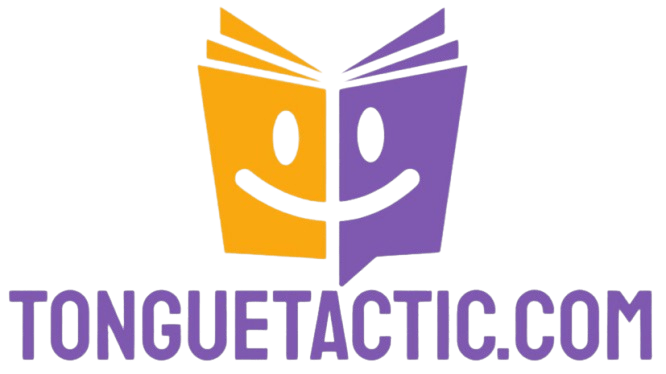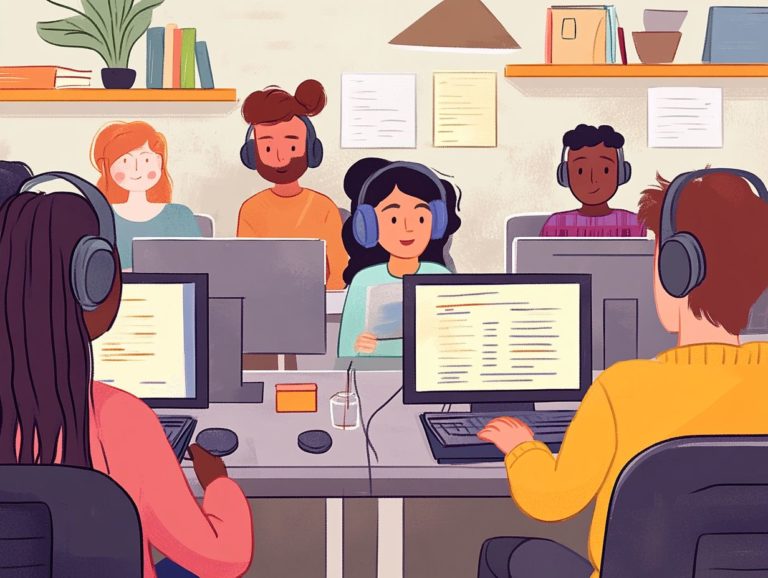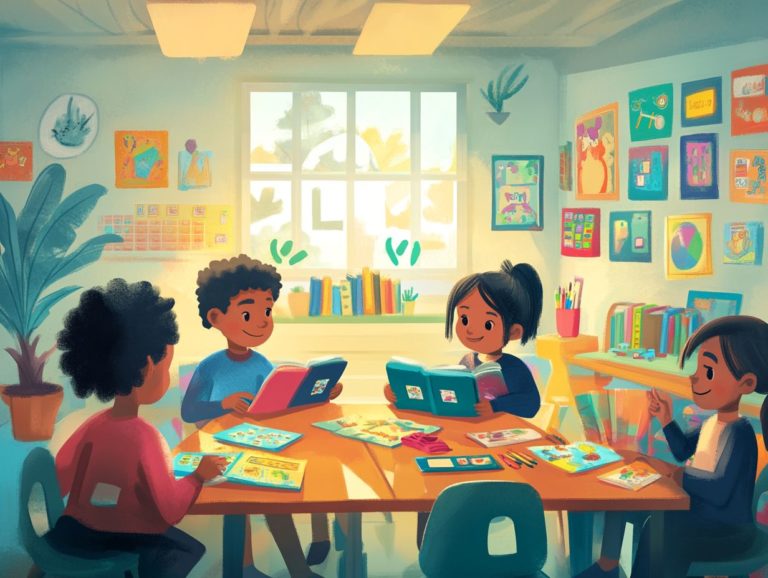the impact of ai on language learning tools
In today s fast-paced digital world, technology is fundamentally reshaping how you learn languages. With personalized lessons designed to meet your unique needs and tools that enhance both efficiency and accessibility, the landscape of language education is undergoing a remarkable transformation.
Like any technology, it presents its own set of challenges and limitations. This article delves into the benefits and potential drawbacks of incorporating technology into language learning. It offers best practices for seamless integration and speculates on what the future may hold at this exciting crossroads of technology and education.
Get ready to dive into this exciting exploration to see how these advancements can elevate your language learning journey!
Contents
- Discover Key Takeaways!
- Benefits of AI in Language Learning Tools
- Improved Personalization and Adaptability
- Efficiency and Accessibility
- Potential Drawbacks of AI in Language Learning
- Limitations and Challenges
- Incorporating AI into Language Learning
- The Future of AI in Language Learning
- Frequently Asked Questions
- What is AI and how is it relevant to language learning tools?
- How does AI improve the efficiency of language learning tools?
- Can AI replace human language teachers?
- What are the potential drawbacks of using AI in language learning tools?
- How do AI-based language learning tools impact accessibility?
- What does the future hold for AI in language learning tools?
Discover Key Takeaways!

- AI enhances language learning tools by improving personalization and adaptability, making the learning process more efficient and accessible.
- Potential limitations and challenges exist, such as the need for reliable data and the risk of replacing human interaction.
- Incorporating AI into language learning requires careful consideration and best practices.
- Exciting advancements in the future are on the horizon!
What is AI and How is it Used in Language Learning?
AI is changing the way we learn languages! By harnessing the latest advancements in technology that helps computers understand and process human language, educational startups and established companies like Duolingo and Babbel have crafted innovative language learning apps tailored just for you.
These applications use chatbots for study sessions, machine translation for clarity, and gamification elements to keep you engaged and motivated. As AI language models continue to advance, they provide you with instant feedback, making your language acquisition process not only more effective but also more enjoyable as they address both academic challenges and cultural nuances.
AI doesn t just personalize your learning experience; it also tracks your progress meticulously. This allows for targeted practice in specific areas, whether it s vocabulary enhancement or grammar refinement. Intelligent tutoring systems adapt lessons in real-time, ensuring that the pace matches your comfort level and helps prevent any feelings of overwhelm.
Machine translation tools integrated into educational software further enrich your understanding by offering contextual translations that deepen your comprehension. AI-driven interactive platforms create collaborative learning experiences, connecting you with students from around the globe.
Embrace these technologies to unlock endless opportunities for learning and cultural exchange!
Benefits of AI in Language Learning Tools
The integration of AI into language learning tools brings a wealth of benefits that can genuinely elevate your learning experience. To understand more about this transformation, consider exploring the impact of AI on language learning tools. These tools leverage sophisticated AI algorithms to tailor themselves to your unique needs, offering personalized learning paths that accommodate a range of proficiency levels.
Practical applications showcased in language learning apps like Mondly and Grammarly allow you to engage in interactive conversations and activities specifically designed to enhance your conversational skills and overall language proficiency.
These AI-powered platforms also feature feedback mechanisms that provide you with instant insights. This fosters effective learning outcomes and allows you to progress with confidence.
Improved Personalization and Adaptability
AI in language learning can greatly personalize your educational experience. It uses advanced algorithms to create a unique journey tailored to your learning style, preferences, and skill level.
This means you receive lessons that truly resonate with your needs. Adaptive learning methods change based on how well you understand the material, speeding up your grasp of vocabulary and grammar. This personalized approach also fuels your motivation by presenting content that aligns perfectly with your interests.
For example, an AI-driven platform might analyze your previous interactions to customize future exercises. This ensures that challenges are just right not too daunting or too easy.
However, developers face the challenge of balancing this tailored experience with the vital need to safeguard your personal information. Transparency about data collection practices and robust security measures are crucial. This creates an environment where you can fully benefit from AI innovations without compromising your privacy.
Efficiency and Accessibility

AI-powered language learning tools are transforming language education, enhancing both efficiency and accessibility, making it more attainable for you, the learner. This transformation is part of the impact of technology on language courses.
These eLearning services harness cutting-edge technologies like machine translation and instant feedback from AI. This streamlines the process, allowing you to pick up new languages far more swiftly than with traditional methods.
With language tutoring available around the clock through chatbots, you have 24/7 access to support. This perfectly caters to different time zones and schedules, truly democratizing language education.
Jump into exciting interactive exercises designed just for you on platforms like Duolingo and Babbel. These exercises are tailored to your individual pace, ensuring a personalized and effective learning experience.
Speech recognition technology becomes your ally, helping you fine-tune your pronunciation with real-time corrections. This significantly boosts your confidence and fluency.
AI-driven language exchanges let you connect easily with native speakers through convenient online interfaces. This technology makes language learning more engaging for you and opens doors for countless individuals who may have previously faced barriers.
Potential Drawbacks of AI in Language Learning
While the advantages of AI in language learning are substantial, it’s imperative to also consider the potential drawbacks, especially regarding academic challenges and user data privacy.
As AI applications increasingly weave into educational frameworks, you may encounter issues like the limitations of AI algorithms in grasping cultural nuances and specific student needs.
Moreover, safeguarding the privacy and security of user data becomes crucial, as these technologies collect extensive amounts of information.
Acknowledging these challenges is vital for developing balanced and effective language learning tools that truly enhance your educational experience.
Limitations and Challenges
Despite the remarkable strides made by AI, certain limitations persist within the algorithms that power these language learning tools. AI provides instant feedback, but it often misses cultural nuances in language. It may also misinterpret your specific learning needs.
This oversight can result in incomplete or potentially misleading learning experiences for you. Acknowledging these limitations is essential for enhancing AI applications in language education.
AI frequently overlooks the subtleties associated with slang, idioms, and culturally significant references that can differ greatly among various speakers. For instance, if you re learning English, you might receive constructive feedback on grammar but miss out on the deeper cultural implications of certain expressions.
To tackle these challenges, developers could incorporate cultural lessons into AI programs or collaborate with local educators to offer context-rich content. Additionally, personalizing your learning experience by allowing you to input your interests and specific goals could enable the AI to tailor its responses, making language acquisition more relevant and effective for you as an individual learner.
Incorporating AI into Language Learning
Incorporating AI into your language learning journey requires a strategic approach. It should align with modern educational technology and effective teaching methods.
Successfully integrating AI can revolutionize traditional language tutoring. It enriches the curriculum with learning methods that change based on your needs and AI-driven resources tailored to your unique learning style.
Embracing best practices equips educators with the skills to use these tools effectively. This ensures that technology enhances rather than replaces human instruction.
This approach creates a supportive and engaging learning environment, elevating your educational experience.
Best Practices and Tips

Implementing best practices for AI integration in language learning can significantly elevate your personalized learning experiences. It can also improve language acquisition outcomes. Focus on crafting engagement activities that resonate with your interests and learning goals.
By leveraging data analytics to tailor content, you can enhance the effectiveness of language learning tools. This ensures that you stay motivated and engaged throughout your journey. To maximize the potential of AI, consider incorporating:
- Interactive quizzes
- Gamified lessons
- Chatbots that simulate real-time conversations
These engaging activities capture your attention and provide meaningful practice opportunities. Utilizing data analytics allows instructors to pinpoint your individual strengths and weaknesses. This enables timely interventions and customized lesson plans that cater to your unique needs.
Using videos and podcasts can enrich your learning environment. This makes each session dynamic and enjoyable. The strategic integration of technology promotes active engagement and gives you the power to take charge of your educational path.
The Future of AI in Language Learning
The future of AI in language learning holds great promise. Numerous predictions and possibilities arise from continuous advancements in AI applications and educational technologies.
As companies like Intellias and innovative educational startups explore the immense potential of AI, you can anticipate increasingly sophisticated language learning tools. These will offer enhanced personalization, engagement, and effectiveness.
This evolution could pave the way for entirely new paradigms in language acquisition. These advancements will leverage cutting-edge AI language models to bridge gaps in proficiency and foster deeper cultural understanding.
Predictions and Possibilities
Predictions about the future of AI in language learning indicate an extraordinary transformation toward more intuitive AI language models. These will elevate the educational experience.
As AI becomes increasingly integrated into educational technology, expect tools that deliver personalized learning experiences. They will also adapt in real-time to your evolving needs as a student. This evolution promises richer language acquisition experiences, where AI actively engages you in interactive conversations. It will incorporate gamification elements to keep your interest piqued.
Advanced AI systems will likely utilize natural language processing to provide instant feedback. This will enable you to correct mistakes and enhance your proficiency with remarkable speed.
The ability to simulate realistic conversational partners will create a safe space for you to practice essential language skills without the fear of judgment.
AI can also encourage collaborative learning by connecting you with peers. This allows you to embark on shared language learning adventures.
Educators can harness these sophisticated tools now to transform learning. The future may reveal a highly interactive and engaging landscape of language education that fundamentally transforms how individuals like you acquire new languages in an increasingly globalized world.
Frequently Asked Questions
What is AI and how is it relevant to language learning tools?

AI stands for artificial intelligence. It allows machines to perform tasks that usually need human intelligence, like learning and problem-solving.
In language learning tools, AI personalizes the experience, provides instant feedback, and adapts to each learner’s needs.
How does AI improve the efficiency of language learning tools?
AI processes large amounts of data to find patterns. This helps create customized lesson plans and gives targeted feedback.
As a result, learners save time and can focus on what they need to improve. This leads to more effective learning.
Can AI replace human language teachers?
No, AI cannot fully replace human teachers. While it offers instant feedback and personalized plans, it lacks the empathy and cultural insights only humans possess.
AI is here to enhance learning, not to take over.
What are the potential drawbacks of using AI in language learning tools?
One drawback is that if AI isn’t trained properly, it may lack personalization. It can also struggle with cultural sensitivity.
Developers need to regularly update AI to ensure it stays accurate and inclusive.
How do AI-based language learning tools impact accessibility?
AI tools make language learning more accessible by offering customized lessons and instant feedback.
This is especially helpful for those without access to traditional resources or who learn differently.
What does the future hold for AI in language learning tools?
The potential for AI in this field is exciting and ever-growing. In the future, we can expect more advanced AI that understands natural language better.
We will see smarter virtual assistants and chatbots that interact with learners in real-time. AI will truly revolutionize language learning for everyone!





